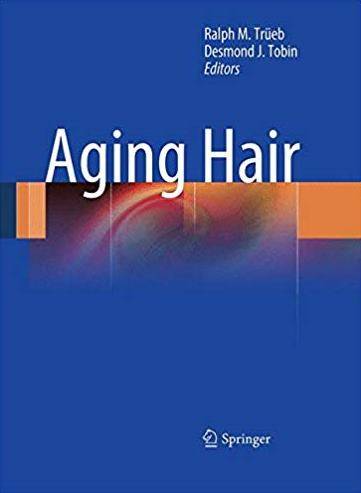
Editors: Ralph M. Trüeb, Desmond J. Tobin
Format: Paperback | 270 pages
Dimensions: 193 x 260 x 20mm | 612g
Publication date: 13 Dec 2014
内容简介:
A comprehensive book that outlines and discusses current concepts for the diagnosis, treatment, and prevention of hair aging
Explains the different causes of hair aging
Provides clear guidance on treatment options and examines future directions for therapeutic intervention
Written by internationally recognized experts for dermatologists and other physicians and scientists interested in the field
“Aged? But he does not appear aged, just look, his hair has remained young!” Marcel Proust, In Search of Lost Time (1913–27) The appearance of hair plays an important role in peoples’ overall physical appe- ance and self-perception. With today’s increasing life-expectation, the desire to look youthful plays a bigger role than ever. The hair care industry has become aware of this, and capable to deliver active products that are directed toward meeting this c- sumer demand. The discovery of pharmacological targets and the development of safe and effective drugs such as minoxidil and fnasteride also indicate strategies of the drug industry for maintenance of healthy and beautiful hair in the young and old. The study of hair aging focuses on two main streams of interest: On the one hand, the esthetic problem of aging hair and its management, in other words everything that happens outside the skin; on the other hand, the biological problem of aging hair, in terms of microscopic, biochemical, and molecular changes, in other words the “secret life” of the hair follicle in the depth of the skin. Hair aging comprises hair shaft aging, and aging of the hair follicle. The former involves weathering and photoaging of the hair shaft, while the latter manifests as decrease of melanocyte function (graying) and decrease in hair production (alopecia).
Table of Content
1. Gerontobiology of the Hair Follicle
2. Molecular Basis of Androgenetic Alopecia
3. Inflammatory Phenomena and Fibrosis in Androgenetic Alopecia
4. Post-Menopausal Frontal Fibrosing Alopecia
5. Female Pattern Hair Loss
6. Hair Growth Parameters in Pre- and Postmenopausal Women
7. Comparative Histopathology of Androgenetic Alopecia, Diffuse Alopecia, and Senescent Alopecia
8. Comparative Gene Expression Profiling of Senescent and Androgenetic Alopecia Using Microarray
Analysis
9. The Aging Hair Pigmentary Unit
10. Oxidative Stress Associated Melanocyte-Loss and Hair Growth Capacity in the Aging Hair Follicle: A
Model for Tissue-Specific Aging
11. Human Hair Follicle Melanocytes as a Proxy Cell Type in Neurodegeneration Research
12. Effect of UV Radiation on Scalp and Hair Growth
13. Hair Photoaging
14. Effect of Tobacco Smoking on Hair
15. Age-Related General Problems Affecting the Condition of Hair
16. Aging of Scalp and Age-Related Disorders of Scalp
17. Care of Aging Hair and Photoprotection
18. Possibilities and Limitations for Reversal of Age-Related Hair Loss
19. Possibilities and Limitations for Reversal of Age-Related Pigment Loss
20. Evidence-Based Hair Transplantation
21. Future Directions: Gene Polymorphism Diagnostics Relevant to Hair
22. Future Directions: The Known and Unknown Roles of Hair-Follicle Stem Cell Types
23. Future Directions: Bioengineering the Hair Follicle
24. Hair After Death
购买连结:
● Bookdepository: https://bit.ly/2NaRUE9
● Springer: https://bit.ly/35CD8fV
- 还没有人评论,欢迎说说您的想法!
